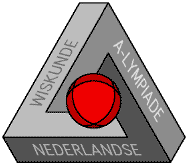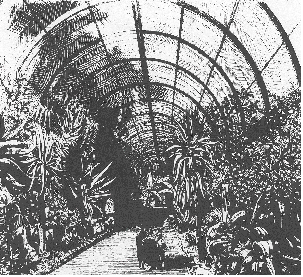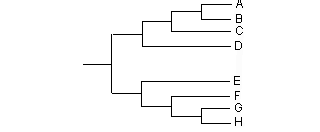 Math A-lympiad: Final
1992-1993
Math A-lympiad: Final
1992-1993 Math A-lympiad: Final
1992-1993
Math A-lympiad: Final
1992-1993
The plants and animals on our planet are having a hard time. Increasing numbers of species are dying out and the continued existence of many others is seriously threatened. Nature conservation institutions are trying to turn the tide both locally and globally. But it seems a hopeless struggle. In addition to the economic and financial problems there are also biological ones: favouring one species is often detrimental to another species. All these problems in maintaining as great a diversity of species as possible have fortunately not stopped the thinking in this respect. Two different aspects of diversity are considered in this assignment. Part 1 is about diversity where the species and numbers are examined. Part 2 is on the genetic relationships between species.
In a rubber plantation the diversity of plants is of course less than in a natural forest. A measure needs to be found for this ‘diversity’. In order to obtain insight into the conditions this measure has to satisfy, four photos of different combinations of five plants A, B, C, D and E, have been made. The following numbers of plants are displayed on each of the photos.
| A | B | C | D | E | |
| photo 1 | 40 | 10 | 20 | 5 | 5 |
| photo 2 | 40 | 20 | - | 25 | 30 |
| photo 3 | 40 | 20 | 10 | 25 | 30 |
| photo 4 | 40 | 30 | 10 | - | 20 |
Experts were asked to rank these photos according to decreasing diversity. They unanimously decided that photo 3 had the greatest diversity, and classified photo 2 ahead of photo 4. They did not all agree on the position of photo 1. Ultimately they came to the following order:

Exercise 1
Specify the factors that were clearly considered to be important for ‘diversity’.
Exercise 2
One of the ways of defining ‘diversity’ is to make it equal to the probability
of getting two different species when arbitrarily selecting two items from the
set. (Formally the selection is without putting the first one back, but here
we will act as if it is put back.) Provide a formula for this definition of
‘diversity’. Examine how the formula behaves, for example by looking at: the
boundaries of the diversity; when the diversity has a maximum value for a collection
of s species. Can you give a formula for this maximum diversity? What role does
this maximum diversity play?
Exercise 3
Is the result of the definition of exercise 2 consistent with the result of
the ranking of the photos? What will be the effect on diversity of thinning
out one or more plants?
Up until now we have only looked at the ratios of numbers of species and plants.
In principle every species is just as important for diversity. But there is
also a case for considering that not all species are equally important. When
it comes to the conservation of species, the genetic variation is of greater
interest. There are scientists who have tried to develop certain criteria for
this.
The current thinking with some biologists is: let’s abandon the high ideal of
conserving almost all species as unachievable and instead direct our efforts
to preserving a limited number of species. These species must be chosen sensibly.
A new problem now arises: who decides, and in what way, which species get a
place on the ark, so to speak? (Remember Noah in the Bible, Gen. 6, 14-22.)
In order to avoid being completely arbitrary, we have to try and devise a reasonably
objective system which takes the importance of the species into account, as
seen from a genetic point of view. This then has to lead to a (relative) value
scale: for example from 0 percent to 100 percent, or by setting the lowest position
to 1, and then setting the rest in relation to that.
Each species is given a position on the value scale. As it is not economically possible to preserve all species threatened with extinction, we will have to concentrate on the species that score the highest on the value scale. In addition, the difficulty of saving a particular species can also play a role.
People may have different opinions on which aspects have to be considered as
important. But it is in any case an attempt to achieve an objective system.
Various biologists have already started doing preliminary exercises for developing
such a system. They start with this hypothesis: it is desirable for the diversity
of hereditary properties to be kept as great as possible (consider the need
for resistant and productive races). They thereby use genealogical trees. Such
a genealogical tree gives the level of genetic relatedness for a group of species.
Below is an example of a group consisting of five species A, B, C, D and E.

This genealogical tree is used to indicate that A and B are more closely genetically related than A and D for example. Thus if only two species can be saved, the combination of B and D is better than the combination of A and B, for example. Therefore D will be somewhat higher up the value scale than A. How much higher depends on the entire set.
Exercise 4
Design a value scale for this group of five species.
One must be able to read from this which species you would first sacrifice if
you ‘were playing Noah’. If (alas!) one species dies out, a new situation arises.
A new value scale is then required. Try to make an overview in which the next
‘victims’ can be seen.
The value scale that you designed in exercise 4 is hopefully better than ‘considering every species as equal’, but it is still not ideal. In a group with many species a certain species can obtain an extreme score. A system that gives rather flatter results is better for such a case.
Exercise 5
Design one or more such systems and discuss the advantages and disadvantages
with respect to the previous system, or the relative advantages and disadvantages
of the new systems with respect to one another.
Clue: you can take the two trees below as a starting point for your discussion,
and they can be compared to one another in the different systems.


If only the nodes and branches are considered, there is no difference between the following situations:

If you also take time into account and proceed on the basis that the differences between species become greater with time, then the situations are no longer the same. In the one case it seems reasonable that C is weighted more heavily than A or B. In the other case it is fairer to allocate roughly the same weight to A, B and C. A genealogical tree in which time also plays a role is called an evolution tree.
Exercise 6
Design a general system that also takes time into account. Discuss this system
by applying it to the following situation:

Put your ideas and findings into a report. It may be an ongoing account where you can choose to emphasise certain aspects yourself. It is thus not important if not all of the exercises have been tackled to the same depth.